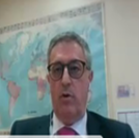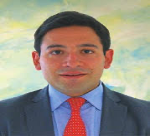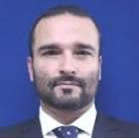Disponible en Español![]()
I Course on Financial Market Infrastructures
Digital course. November 23 - 27, 2020
The Center for Latin American Monetary Studies and the Banco de España joined forces to organize the first edition of Course on Financial Market Infrastructures. This is an annual capacity-building event that will replace the payment systems trainings held by CEMLA and Bank of Spain separately. It will promote a combination of academic and practitioner sessions to provide a holistic set of capacities for the participants coming from Latin American and Caribbean Central Banks.
The Center for Latin American Monetary Studies (CEMLA) and the Banco de España held the I Course on Financial Market Infrastructures in digital format, from November 23 to 27, 2020. The Course was attended by over 70 participants representing Latin American and Caribbean central banks and securities commissions.
The objective of the Course was to enrich the knowledge of the participants on the design, operation, regulation and oversight of financial market infrastructures by presenting and discussing different current issues.
Participants learnt about the role of central banks in financial market infrastructures as operators, catalysts and overseers. They were presented with important changes in the payments and market infrastructures landscape that will significantly change the roles of the central banks, including the challenges for cyber security and the regulation of payment innovations. The future of retail Central Bank of Digital Currencies was also presented.
There was a special focus on advanced analytical tools to monitor and design payment and market infrastructures, using network analysis, machine learning and asset pricing techniques.
The Course concluded with a roundtable with the participants to discuss some of the main challenges facing central banks to maintain the safety and efficiency of payment systems and market infrastructures, given the developments that are taking place at the international level. It was heavily discussed how central bank are becoming agents of change with a more active participation in providing payment services and systems to underpin interoperability, access and innovation. Given the ongoing developments with different payment innovations, participants also concluded that the regulation and oversight of the financial market infrastructures is likely to change and central banks must prepare accordingly.
Monday, November 23
Welcome remarks
Dr. Manuel Ramos Francia, Director General, CEMLA
Dr. Juan Ayuso Huertas, Director General of Operations, Markets and Payment Systems, Bank of Spain
A general framework for payment systems and market infrastructures ![]()
Francisco Linares Moreno, Banco de España
In this session, participants learned about the role of central banks in financial market infrastructures as operators, catalysts and watchdogs. Other topics to be presented include the use of infrastructures for the implementation of monetary policy and for the management of guarantees (the triangle between central securities depositories, payment systems and collateral management mechanisms); fundamental concepts such as settlement in central bank money versus commercial bank money; purpose; real-time gross settlement vs deferred net settlement; overnight vs intraday settlement; and, an overview of infrastructure in Europe.
Overview of the Financial Market Infrastructures in Latin America and the Caribbean ![]()
Raul Morales Resendiz, CEMLA
In this session, the participants learned about relevant aspects of the payment systems and market infrastructures of the region, including their main functions and uses. Topics presented include recent trends in wholesale and retail payments, the characteristics of existing infrastructures, and the current institutional framework.
Surveillance and Regulation for Financial Market Infrastructures ![]()
Desirée Aleman Rodriguez, Banco de España
In this session, participants learned about surveillance concepts and standards, and the most relevant risks to consider. Other topics that were presented include the Eurosystem surveillance framework; surveillance of critical service providers; the analysis of interdependencies; crisis management in financial market infrastructures; and, the role of cooperation.
Tuesday, November 24
Cybersecurity in Financial Market Infrastructures ![]()
Cristina Garcia Medina, Banco de España
In this session, participants learned about several initiatives to strengthen the capacity of infrastructures to identify, detect, protect and recover from cyber risks, including the CPMI-IOSCO guide on cyber resilience, the Cyber Resiliance Oversight Expectations and the Threat framework. Intelligence Based Ethical Red-Teaming of the European Central Bank.
Liquidity and Payment Systems: Fundamentals and Practical Aspects ![]()
Biliana Alexandrova, Banco de Mexico
In this session, the participants obtained knowledge about the characteristics and relevance of payment systems and market infrastructures for the provision of liquidity in financial markets. Analyzing the payment data is essential to understand and identify anomalous behavior in the participants of the payment system. This session focused on establishing a framework to monitor liquidity needs and flows through payment systems.
Analytical tools for Monitoring in Financial Market Infrastructures ![]()
Carlos Leon, Banco de la Republica
In this session, participants gained insight into the timeliness, granularity, and reliability of data in financial market infrastructures to identify and analyze financial risks. This session introduced some applications to carry out risk analysis and monitoring tasks. Emphasis was placed on the methodologies used to leverage this data (e.g., network analysis, payment simulation, machine learning), as well as individual and aggregated indicators that serve as an analysis and monitoring tool.
Wednesday, November 25
Analysis of Financial Networks in Payment Systems ![]()
Biliana Alexandrova, Banco de Mexico
In this session, participants were introduced to network analysis in payments and market infrastructures. The session provided a framework and practical applications on how central banks can approach payments data to monitor financial market infrastructures for risk management and supervision purposes.
Central Counterparty Entities ![]()
Jorge Cruz Lopez, Financial Network Analytics y Universidad de Western Ontario
In this session, participants learned about the functioning and role played by these financial market infrastructures. Financial risks in trading, clearing and settlement of financial asset transactions are a growing source of contagion, Central Counterparties (CCPs) aim to address concerns about risks and can be used as an operational tool to enable development markets. This session helped participants understand how the CCP should be designed to meet their policy objectives.
Country Presentations: Recent Developments in Financial Market Infrastructures
Session moderated by Raul Morales, CEMLA
Presenters
- Milton Vega, Banco Central de Reserva del Peru
- Guilherme Buscacio y Alexandre Dimas, Banco Central do Brasil
- Jose Pantaleon, Banco Central de la Republica Dominicana
Thursday, November 26
The economics of retail payments ![]()
Jose Aurazo, Banco Central de Reserva del Peru
In this session, participants learned about the main economic characteristics of retail payment markets. Two-sided markets have special structure and prices, which are decisive for both users and providers, retail payment services show this kind of economy. The session focused on recent developments in how the economics of retail payments should be understood in emerging markets.
Payments and Financial Inclusion in Latin America and the Caribbean ![]()
Raúl Morales Resendiz, CEMLA
In this session, participants gained knowledge about the role of payments as a means of accessing the financial system. The framework of this session will be the PAFI Guiding Principles and their application to the economies of Latin America and the Caribbean, including an evaluation of the effectiveness of payment strategies for financial inclusion. Country experiences will be presented as part of relevant emerging practices.
Innovation in Payment Systems (I)
Miguel Perez Garcia de Mirasierra, Banco de España
In this session, participants learned about innovations in retail payments, focusing on immediate payments and related risk management, the importance of improving point-of-sale and e-commerce solutions based on credit transfers (barriers, conditions for an optimal solution, etc.) Other topics presented include the introduction of new services and providers, and the need for higher security requirements (with reference to the Payment Services Directive, PSD2).
Innovation in Payment Systems (II)
Justo Arenillas Cristobal, Banco de España
In this session, participants learned about innovations in wholesale payment systems, with a special focus on the role of non-bank participants and their access to LBTR systems, and issues related to cross-border payments from the point of view of interoperability and initiatives such as SWIFT GPI.
Friday, November 27
Central Bank Digital Currencies ![]()
Francisco Rivadeneyra, Bank of Canada
In this session, participants gained insight into the four key dimensions for analyzing the evolution of Central Bank digital currencies, including motivations, design and implementation, monetary and banking implications, and alternatives for central banks.
Regulatory aspects of fintech in Latin America and the Caribbean ![]()
Raul Morales Resendiz, CEMLA
In this session, the participants learned about the main regulatory mechanisms for payments developments based on the new financial technologies applied in the region, with an emphasis on risks and approaches to address them.
Round table: Future Challenges for the Financial Market Infrastructures of the Region
In this session, the participants discussed some of the main challenges facing central banks to maintain the security and efficiency of payment systems and market infrastructures, given the developments that are taking place at the international level. The organizers facilitated this discussion through a series of guiding questions that will be provided to the participants in advance.
 Francisco Linares Moreno
Francisco Linares Moreno
Banco de España
Graduated in Economics from the Complutense University of Madrid, he has developed his entire professional career at the Banco de España, where he joined in 1987. His duties have always been linked to aspects related to payment systems and instruments, having exercised responsibilities in different areas such as the management of settlement systems, such as TARGET, the surveillance of financial market infrastructures or the monitoring and development of initiatives in this area, such as the Single Zone of Payments in Euros -SEPA-. He is currently responsible for the Division in charge of providing payment services to account holders at the Banco de España, in accordance with the provisions of the Autonomy Law and the specific agreements signed with different national organizations (Treasury, Social Security, Autonomous Communities, among others) and international (central banks, for example).
Representative of the Banco de España in various national working groups and of the Eurosystem where aspects related to payment systems and instruments are discussed. Likewise, it collaborates with international organizations such as the World Bank or CEMLA, participating in various international initiatives and missions and representing the Bank of Spain in the Western Hemisphere Payment and Securities Settlement Forum and in its International Advisory Council; She is also a member of the Working Group on Payment System Issues of Latin America and the Caribbean (WGPS-LAC).
 Raúl Morales
Raúl Morales
Center for Latin American Monetary Studies (CEMLA)
Raul Morales Resendiz has been Manager of Infrastructures and Financial Markets since 2013. In this position, he is responsible for promoting technical cooperation activities among CEMLA members, coordinating groups of experts, preparing research and policy analysis, facilitating technical assistance and coordinating events to capacity building. Mr. Morales was responsible for establishing a group of central banking experts on Fintech, dedicated to helping central banks better understand the implications of new technologies. His other responsibilities include the technical secretariat of the expert groups on market operations, payment and market infrastructures, cybersecurity, financial information and accounting regulation, as well as representing the Center in international committees on payments and financial inclusion and on fintech data. Mr. Morales advised CEMLA's General Directorate on international affairs between 2013 and 2014 and in 2018. He has been invited as a lecturer in several international forums, including the following: SWIFT regional conference, ECB regional conference on retail payments, cyber security, annual meeting of SUCRE, Cooperation Council for the Arab States of the Gulf, meeting of the WSBI assembly and other public and private events organized by the national central banks of the region.
He holds a degree in Economics from the Universidad Nacional Autonoma de Mexico (UNAM), a master's degree in Economics and Public Policy from the Instituto Tecnologico y de Estudios Superiores de Monterrey (ITESM) and a diploma in public policy and leadership from Georgetown University.
 Desirée Alemán Rodríguez
Desirée Alemán Rodríguez
Banco de España
She has a degree in law and economics from the Carlos III University of Madrid, studies that she combined with stays at the Luigi Bocconi University of Milan and at the Arizona State University in the US, additionally, she has a Master's degree in Research in Economics from the UNED de Madrid. He joined the Banco de España in 2011, where she has always developed his work in the field of payments, first in the area of payments policy, on issues such as innovations in payments or the implementation of the Single Payment Zone in Euros (SEPA, for its acronym in English) and, later, in the surveillance area. After a time at the European Central Bank, also in the payment surveillance area, he rejoined the Banco de España, currently working in the field of surveillance of retail systems and payment schemes (SNCE and STMP) and in equipment work of the Eurosystem including the development of the new PISA surveillance framework.
 Cristina García Medina
Cristina García Medina
Banco de España
She has a degree in law and in business administration and management from the Universidad Pontificia Comillas de Madrid. In 2011 he joined the Banco de España, specifically the Securities Settlement Systems Unit, his area of specialization being central counterparty entities. Since March 2016, she has been part of the working group that has developed the cyber risk surveillance strategy for euro central banks and has developed the available instruments such as: the cyber resilience survey, surveillance expectations, and the framework TIBER for red teaming tests.
 Biliana Alexandrova
Biliana Alexandrova
Banco de México
Biliana Alexandrova Kabadjova has been working at Banco de México since February 1997. She obtained her Bachelor's degree in Administrative Computing Systems with honors at the ITESM-Campus Ciudad de Mexico in December 1996. She received her Master's Degree in Computer Science and her PhD in Computational Finance at the University of Essex, UK in 2003 and 2007 respectively. Since January 2009 she has been a permanent member of the National System of Researchers (SIN, Level 1) and has published more than 35 articles in peer-reviewed journals and book chapters. Biliana Alexandrova has participated in the edition of two books: “Simulation in Computational Finance and Economics: Tools and Emerging Applications” and “Analyzing the Economics of Financial Market Infrastructures”. Her research is focused on financial market infrastructures using artificial intelligence, network analysis and agent-based models.
 Carlos León
Carlos León
Banco de la República
Leader and active participant in a research agenda that is dedicated to studying, developing, implementing and disseminating models that contribute to financial stability, a better understanding of financial markets, and the monitoring of financial institutions and infrastructures that participate in the Colombian financial market.
Principal Investigator of the Financial Infrastructure Monitoring Department. He has a PhD in Finance from the University of Tilburg (The Netherlands); Master's degree in Banking and Finance from the University of Lausanne (Switzerland); as a specialist in International Economics from the Externado de Colombia University; and as a professional in Finance and International Relations from the Externado de Colombia University.
 Jorge Cruz López
Jorge Cruz López
Financial Network Analytics y Universidad de Western Ontario
Jorge is the Director of Financial Engineering and Research at FNA. He is also an Assistant Professor in the Department of Economics at the University of Western Ontario and a member of the Advisory Board of the New York Institute of Finance. His research interests include financial asset pricing, financial risk management, and financial market infrastructures (FMIs).
At FNA, Jorge oversees the R&D Department. He leads a team of data scientists in the development of analytical models, visualizations, and algorithms that facilitate the management and supervision of financial and operational risks. He is also responsible for establishing a research program to engage the academic and regulatory communities.
Jorge joined FNA in 2019 after spending eight years at the Bank of Canada, where he worked as a Senior Economist and as a Principal Researcher. At the Bank of Canada, he conducted research and oversaw policy work in the areas of financial market infrastructures (FMIs), asset pricing, financial stability, and risk management. He also participated in multiple working groups relating to the regulation of derivatives markets and the modernization of payment systems, in addition to serving as the Associate Editor of the Bank of Canada Financial System Review.
Jorge has published in academic and practitioner journals, served in editorial boards, and spoken at several conferences, universities, and policy institutions, including the Bank for International Settlements (BIS) and various central banks. He has been a Visiting Scholar at HEC Paris and at Queensland University of Technology, and has held teaching positions in the business schools of Carleton University, the University of Ottawa and Simon Fraser University, where obtained a PhD in Finance in 2014.
 Milton Vega
Milton Vega
Banco Central de Reserva del Perú
Milton Vega, Deputy Manager of Payments and Financial Infrastructures, Central Bank of Peru.
Mr. Vega studied economics at the University of Lima (1979) and holds two Master Degrees: Economics at the London School of Economics and Political Science (1984), and Public Administration at Harvard University (1991). In addition, he has participated in several international courses and seminars.
Mr. Vega has been Deputy Manager of Payment Systems at the Central Bank since March 2008. He is in charge of the regulation and supervision of payment systems and services and the administration of the Gross Settlement System in Real Time in Peru and the Central Bank Securities Settlement System, among other functions. He participated in the team that drafted the Law on Payment and Securities Settlement Systems and the Electronic Money Law and he has been a speaker in various seminars and courses and published several papers focused on payment systems in Peru.
 José Aurazo
José Aurazo
Banco Central de Reserva del Perú
Master in Economics from the Universidad del Pacifico (Lima, Peru). He currently works as Specialized Supervisor in Analysis of Financial Infrastructures of the BCRP, has more than 5 years of experience in the field of retail payments; mainly, analyzing the card industry. He has completed a research internship organized by the Swiss Cooperation (SECO) and under the supervision of Jean-Charles Rochet. It also has training courses organized by CEMLA, European Central Bank, Banco de la Republica, among others.
 Miguel Pérez García de Mirasierra
Miguel Pérez García de Mirasierra
Banco de España
He is a Civil Engineer from the Polytechnic University of Madrid. In 1989 he joined the Banco de España, the Department of Economic Situation and Forecast in the Research Service. In 2008, he joined the Payment Systems Department, where he has held different responsibilities and held various positions. He is currently in charge of the Market Infrastructure Surveillance and Analysis Unit, within the Payment Surveillance and Supervision Division.
 Justo Arenillas Cristóbal
Justo Arenillas Cristóbal
Banco de España
He has a degree in Economics from the Autonomous University of Madrid and an MBA from the University of Minnesota, USA He has recently joined the Banco de España as an expert in the Market Infrastructure Monitoring and Analysis Unit. Previously, he spent two years at the European Central Bank. He has more than 15 years of experience in retail payment methods; in the ServiRed domestic card system, in the international VISA scheme and in BBVA.
 Francisco Rivadeneyra
Francisco Rivadeneyra
Bank of Canada
Francisco Rivadeneyra is a Director of CBDC and Fintech Policy and Research at the Bank of Canada. His research is broadly divided into financial economics and payments research. He is interested in how agent heterogeneity and payments infrastructure affect asset prices and welfare. His recent academic research focuses on the implications of technological innovations, for example electronic money and distributed ledger technologies, for the mandates of central banks. His recent policy work has been to develop computational tools to measure the risk and efficiency of payments systems. Earlier work focused on the management of domestic debt and foreign reserves portfolios.
Mr. Rivadeneyra holds a PhD in Economics from the University of Chicago.
- Working Group on Payment System Issues for Latin America and the Caribbean: https://www.cemla.org/forodepagos/
- Banco de España: https://www.bde.es/bde/es/areas/sispago/

